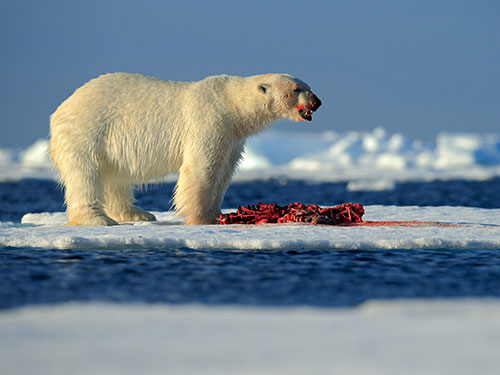The nine planetary boundaries
The current set of planetary boundaries
Below is a shortened summary of each of the Planetary Boundaries (source: www.stockholmresilience.org):
Climate change
Measurements show that CO2 concentrations of 390ppm (parts per million parts of air in our atmosphere) have significantly risen since pre-industrial times (280ppm). CO2 is one of the naturally occurring substances known as Greenhouse Gases (GHG) and makes life on Earth possible by preventing too much heat from leaving the atmosphere, amongst other things. However, since a proportion of human CO2 emissions from the excessive burning of fossil fuels and forests remains in the atmosphere for over 1000 years, it causes long-lasting irreversible effects. Effects that can accelerate and further intensify climate impacts, such as the melting of polar sea ice, releasing methane from melting tundra soil (another GHG, 21 times more potent than CO2), or the destruction of rainforests.
Novel entities and chemical pollution
Emissions of toxic and long-lasting substances, including synthetic pollutants, heavy metals and radioactive materials, can cause irreversible changes in organisms, ecosystems and the climate, even over large distances. Examples include genetic damage, cancer and infertility.
Stratospheric ozone depletion
The ozone layer filters out ultraviolet (UV) radiation from the Sun, preventing skin cancer and damage to biological systems. Because of all the actions taken as a result of the Montreal Protocol, we seem to be on a path that will allow us to stay within this boundary.
Atmospheric aerosol loading
Various particles from societal and land-based emissions affect cloud formation as well as global and regional atmospheric circulation, including tropical rains and the reflection of sunlight. Inhaling aerosols can have deadly affects on living organisms including humans.
Ocean acidification
A quarter of human CO2 emissions are dissolved in oceans where they lower the pH of the surface water and thus prevent the growth and survival of such organisms as corals, shellfish and plankton, leading to global knock-on effects on fish stocks.
Biogeochemical flows
The natural flows and the forms of nitrogen and phosphorus, essential elements for plant growth, have radically changed as a result of industrial and agricultural processes. Biogeochemical flows are polluting the air, water and soil, creating local shortages and abundances as well as affecting ecosystems and food sources.
Freshwater use and the global hydrological cycle
Human pressure is now the dominant driving force that determines the functioning and distribution of global freshwater systems with in some cases abrupt and irreversible changes in global-scale river and vapour flows.
land-system change
Forests, grasslands, wetlands and other vegetation types have been converted to agricultural land, impacting for example the biodiversity and crucial flows of carbon, phosphorus and nitrogen. Hence, land-system change is particularly important in climate change dynamics.
Biosphere integrity, biodiversity loss and extinctions
The increasing demand for food, water and natural resources has been causing severe biodiversity loss and changes in ecosystem services. Ecosystem damage and extinction can be slowed by protecting the integrity of living, enhancing habitat and improving connectivity between ecosystems while maintaining high agricultural productivity.



Key planetary boundaries update in 2015
The recently published 2nd version (2015) is a development of the first publication in 2009. It sharpens and confirms the definitions of the original set of boundaries and provides an updated analysis and quantification of several of them, using the most recent scientific data and academic peer reviews, including The Natural Step’s Framework.
As published in January 2015, four of the nine planetary boundaries have now been violated as a result of human activity: climate change, biogeochemical flows, land-system change and biosphere integrity, especially in regard to phosphorus and nitrogen. Two of these, climate change and biosphere integrity, are so called “core boundaries”. Significantly altering either of these core boundaries would drive the Earth as a system into a new state.
Two of the boundaries have been given new names to better reflect what they represent, and yet others have now also been assessed on a regional level. “Loss of biodiversity” is now called “biosphere integrity”, recognising the interdependencies of species and focusing on the impact of humans on ecosystem functioning. “Chemical pollution” has been given the new name “novel entities”, reflecting the fact that humans can influence the Earth system through new technologies and substances in many ways.
The people behind it

Dr Johan Rockström (centre), Rüdiger Röhrig of The Natural Step Germany (left) and Lin Zhang of The Natural Step China (right); photo Kim Svenson (CC BY/3.0).

Lively discussions at the tables involving thought leaders, business experts, academics and various members of The Natural Step; photo Kim Svenson (CC BY/3.0).